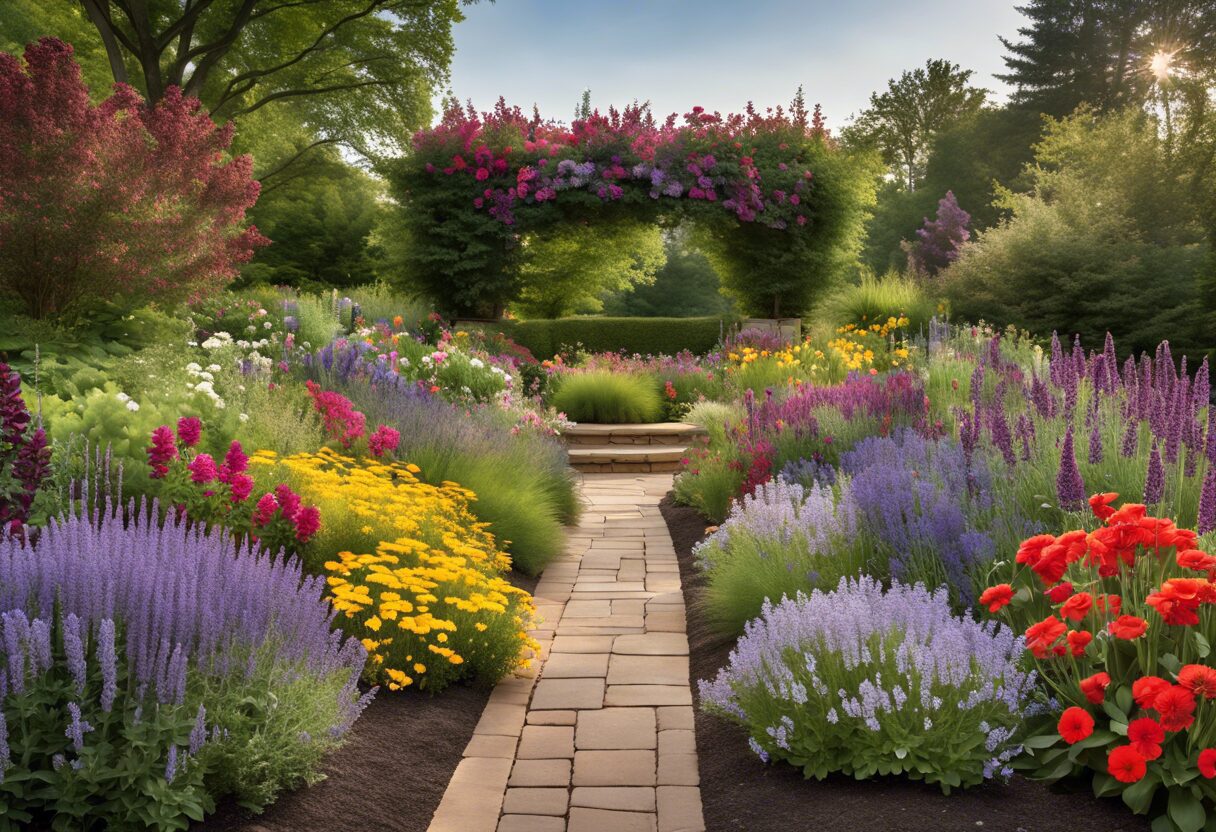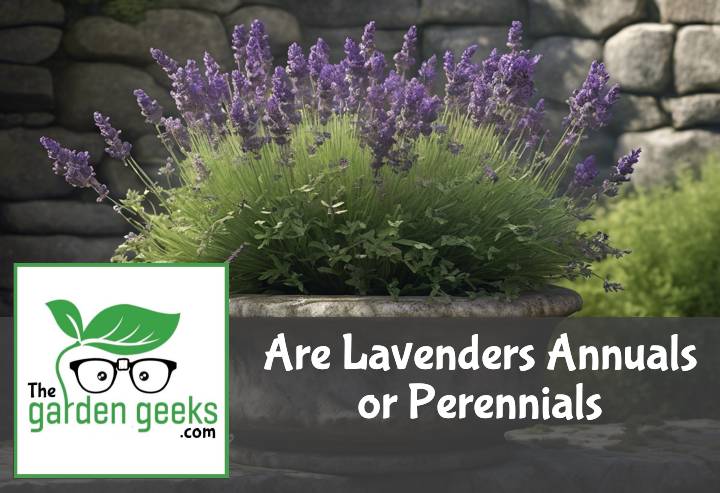Hello there, fellow plant enthusiasts! Ever found yourself musing over your morning coffee, wondering “Are Lavenders Annuals or Perennials?” Well, you’re not alone. It’s a question that’s been bugging gardeners and lavender lovers alike for ages.
In the world of botany, things can get a bit confusing with all these fancy terms. But don’t worry, we’re going to break it all down in layman’s terms. So buckle up and keep reading about Are Lavenders Annuals or Perennials? You might just learn something new today!
Key Takeaways
- Lavenders are perennials, meaning they grow year after year.
- They thrive in USDA hardiness zones 5 through 9.
- However, in colder climates (zones below 5), they can be grown as annuals.
- Proper care and maintenance can extend their life span beyond the typical perennial cycle.
- There are different varieties of lavender with varying degrees of hardiness.

Understanding Lavenders
When it comes to the world of aromatic herbs, lavender is a superstar. This plant, with its lovely purple flowers and calming scent, has some unique characteristics that make it stand out from the crowd.
What are Lavenders?
Lavenders, scientifically known as Lavandula, are a genus of 47 known species of flowering plants in the mint family. These plants are renowned for their vibrant purple or blueish flowers which bloom beautifully under the summer sun.
They’re not just pretty faces though! Lavenders have a wide range of uses. From being used in perfumes and soaps due to their enchanting aroma, to being used in cooking for their unique flavor – lavenders are quite versatile. They’re also popular in landscaping because they’re drought-resistant and can thrive in various climates.
The Origin and Distribution of Lavenders
Now let’s talk about where these beauties come from. Originally, lavenders hailed from the Mediterranean region – think sunny Spain, Italy, France and Greece. However, over time they’ve made themselves at home all around the globe.
Today you’ll find lavender farms flourishing everywhere from North America to Australia! These hardy plants grow best in well-drained soil under full sun exposure. So next time you see a field of purple swaying gently in the breeze, take a moment to appreciate these global trotters who’ve found their way into our gardens and hearts!
Classification of Plants: Annuals and Perennials


When we talk about plant classification, two terms often pop up – annuals and perennials. These are categories based on the life cycles of plants. Now, you might be wondering, what’s the difference between annuals and perennials? Well, let’s dive right in!
What are Annual Plants?
Annual plants are like those one-hit wonders on the radio. They sprout, bloom, produce seeds, and then kick the bucket all within a single year. This is what we call the life cycle of annual plants.
These guys are all about speed. Their mission? To grow fast, reproduce even faster, and make sure their offspring survive before they say adios! That’s why they’re often vibrant and showy – it’s all part of their strategy to attract pollinators for seed production.
What are Perennial Plants?
On the other hand, perennial plants are more like those classic rock bands that stick around forever. They have a longer life cycle, growing stronger over several years.
Unlike annuals who live fast and die young, perennials take things slow. They focus on establishing a strong root system in their first year. Then they return each spring or summer to put on a show with beautiful blooms.
So when someone asks you “Are Lavenders Annuals or Perennials?”, you’ll know how to answer! But hey, no spoilers here – we’ll get to that soon enough!



Are Lavenders Annuals or Perennials?
Well, let’s get straight to it. Are Lavenders Annuals or Perennials? The answer is – drumroll please – perennials! Yes, you heard it right. These fragrant beauties are perennial plants, meaning they live more than two years. Their lavender plant lifespan can extend up to 12 years in ideal conditions. Now that’s a lot of lavender!
Lifespan of Lavender Plants
So, how long does a lavender plant live? On average, these purple wonders can stick around for about 10 to 12 years. But hey, don’t take this as gospel truth! The average lifespan of lavender can be influenced by several factors.
For instance, the type of soil and climate they’re grown in can play a big role. Also, how well you care for your lavenders (yes, they need some TLC too!) can affect their longevity. So if you’re dreaming about a garden full of lavenders year after year, remember the golden rule: maintaining healthy lavenders is key!
Growth Cycle of Lavender Plants
Now let’s talk about the lavender growth cycle. It starts from a tiny seedling and grows into a mature plant over time. And guess what? This journey is not just about getting bigger and taller.
Lavender plants go through different stages throughout the year due to seasonal changes. In springtime, they start budding and by summer, they’re in full bloom (hello beautiful purple fields!). As autumn rolls in, they begin to slow down and prepare for winter dormancy.
Growing lavenders from seedlings might seem like a long process but trust me; seeing those mature lavender plants swaying gently in your garden makes all the wait worthwhile!
Factors Influencing the Lifespan of Lavenders
When it comes to lavender lifespan, there are a few key factors that can make all the difference. We’re talking about things like climate, weather conditions, soil quality, and how you maintain your lavender plants.
Climate and Weather Conditions
First off, let’s chat about climate and weather conditions. You see, lavenders aren’t too picky, but they do have their preferences. They thrive best in Mediterranean climates – think warm, sunny days and cool nights.
But don’t worry if you’re not living in Greece or Italy! Lavender in different climates can still prosper with the right care. Just remember that extreme temperatures can be a bit tough on them.
Hot and humid? Not so great for our fragrant friends. It can lead to issues like root rot and fungal diseases. On the flip side, very cold weather can cause damage too.
The optimal climate for lavender growth is a delicate balance. But with some TLC (and maybe a little luck), you can help your lavender live its best life no matter where you are!
Soil Quality and Maintenance
Now let’s dig into soil quality. Lavenders love well-draining soil with a slightly alkaline pH level. If your soil is more on the clayey side or tends to retain water, it might spell trouble for your lavender plant.
But hey! Don’t lose hope just yet! There are ways to improve your soil conditions. Adding organic matter or sand can improve drainage and create an environment where lavenders will thrive.
And remember – maintaining healthy soil for lavenders isn’t just about the right mix of dirt. Regular watering (but not overwatering!) and pruning also play crucial roles in ensuring your lavender stays happy and healthy.
So whether you’re asking “Are Lavenders Annuals or Perennials?“, remember that with the right conditions and care, these beautiful plants can grace your garden for years to come!
How to Care for Your Lavender Plant
So, you’ve decided to add a splash of purple to your garden with a lavender plant. Good choice! But now you’re probably wondering how to keep this fragrant beauty thriving. Well, lavender plant care isn’t as daunting as it might seem. With the right conditions and a bit of TLC, your lavender will flourish.
Ideal Conditions for Growing Lavender
Now let’s talk about what makes lavender happy. First off, these plants love the sun – we’re talking at least six hours of direct sunlight each day. So make sure you pick a sunny spot in your garden or on your windowsill.
Next up is soil. Lavenders prefer well-draining soil that’s slightly alkaline. If you can get your hands on some sandy or gravelly soil, even better! And remember, lavenders are pretty drought-tolerant once established but they do need regular watering when young.
Temperature-wise, lavenders are hardy plants that can tolerate cool winters and hot summers. However, they don’t like humidity so if you live in a humid area, consider growing them in pots where the drainage can be controlled.
Common Problems and Solutions in Growing Lavender
Despite their resilience, lavenders do face some common issues. Pests like aphids and whiteflies can be troublesome but can be dealt with using insecticidal soap or neem oil.
Diseases such as root rot and fungal infections often occur due to overwatering or poor drainage. The solution? Water less frequently and ensure your lavender is planted in well-draining soil.
And speaking of overwatering – it’s one of the most common mistakes when caring for lavenders. Remember folks, these plants are native to the Mediterranean region which means they’re used to dry conditions. Overwatering can lead to root rot which is often fatal for the plant.
So there you have it – a quick guide on caring for lavender plants. With the right conditions and a watchful eye for common problems, your lavender will be blooming beautifully in no time!


To Wrap Up
In the great debate of “Are Lavenders Annuals or Perennials”, we’ve learned that lavenders are like the superheroes of the plant world – they’re perennials!
So, don’t be a ‘one-season wonder’, let your lavender bloom year after year. Happy gardening!


